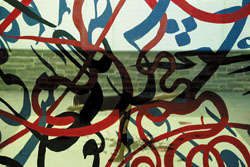

 Shazia Sikhander’s art presents an intricate synthesis between traditional forms – she studied miniature painting in her home city of Lahore, Pakistan – and the more standardized visualizations belonging to our digitized era. In her early exhibitions Sikhander was primarily interested in small format, although she would occasionally expand the canvas beyond its edges and onto the surrounding wall. Even when the composition fills an entire wall, however, Sikhander continues to hew closely to the internal scale of the miniature, in which individual actors are dwarfed by their environments, and forces far beyond mere mortal limits seem to inhabit both the landscape and the heavens.
Shazia Sikhander’s art presents an intricate synthesis between traditional forms – she studied miniature painting in her home city of Lahore, Pakistan – and the more standardized visualizations belonging to our digitized era. In her early exhibitions Sikhander was primarily interested in small format, although she would occasionally expand the canvas beyond its edges and onto the surrounding wall. Even when the composition fills an entire wall, however, Sikhander continues to hew closely to the internal scale of the miniature, in which individual actors are dwarfed by their environments, and forces far beyond mere mortal limits seem to inhabit both the landscape and the heavens.
During the past few years Sikhander has successfully taken up digital animation, often carrying over visual motifs from her non-animated work. She approaches the digital surface less as a screen than as a kind of shadow-box theatre, in which activity unfolds and characters move about without necessarily impacting each other. Little effort is made in Sikhander’s animations to simulate the appearance of three dimensions, and the stiff formality of the figures’ movement echoes the rigid hierarchies of pattern and sequence that gradually take shape as the narrative unfolds.
For the present occasion, Sikhander is showing publicly for the first time a different kind of movement-based work: a collaborative video in which the choreographer has crafted a dance for herself using a mandala-like floor design by Sikhander as a kind of visual guide. The dancer’s movement, which has evolved as much from yoga practice as modern choreography, is recorded from different angles and heights, so that the visual interaction of body and painting is emphasized. To further amplify this dialogue of edges and volumes, Sikhander has also created a drawing whose function is to serve as an outer frame for the rectangular projection. Blown up and painted into place, the function of this framing shape is to reinforce the visual connection with the design on which the figure is dancing, with a particular interest in those moments when the human form in movement appears sandwiched between two drawings in two very different spaces.